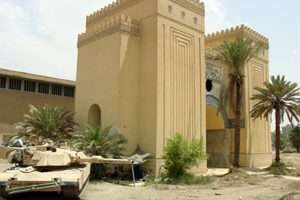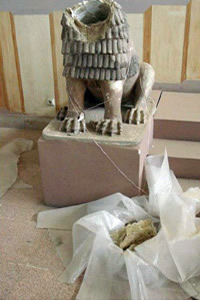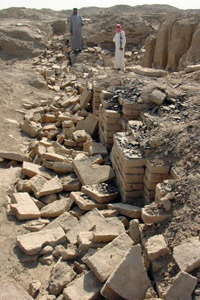O.I. marks 5-year-old ‘catastrophe’ at Baghdad museum: Illicit trade in antiquities promotes looting of unprotected repositories
By William HarmsNews Office
 The damage to the Iraq National Museum in Baghdad, shown directly above, took place in April 2003. A U.S. tank sits outside the entrance to a reconstructed Assyrian gate at the children’s section of the Iraq National Museum with a gaping hole in its façade. All photos courtesy of Joanne Farchakh-Bajjaly |
|
Scholars at the University were leaders in calling attention to the looting of artifacts in Iraq five years ago. They are marking the anniversary of that destruction with a special exhibition and symposium at the Oriental Institute, as well as several public events in Chicago and Washington, D.C.
The exhibition, “Catastrophe! The Destruction and Looting of Iraq’s Past,” will open Thursday, April 10 and run through Wednesday, Dec. 31. The opening marks the anniversary of the 2003 looting of the Iraq National Museum in Baghdad, and the symposium will be held Saturday, April 12. The University’s Cultural Policy Center will release a book of policy analysis and recommendations on Wednesday, April 9, in Washington, D.C.
The exhibition will consist of photographs as well as objects from the museum’s collection. “It summarizes results of investigations into the looting of the Baghdad Museum and updates efforts to recover the artifacts that were stolen,” said Geoff Emberling, Director of the Oriental Institute Museum.
The exhibition also will document the looting of archaeological sites with a series of aerial photographs that show the increase in damage through the past few years and other ground-level pictures of the looters at work. “A central section illustrates the importance of archaeological context through several case studies that show what is lost when a piece is looted. The exhibit presents an overview of the international trade in antiquities and the ways in which it directly promotes the looting of the sites,” Emberling said.
The exhibition also will summarize international efforts to prevent the looting and will offer additional suggestions to stop this activity.
McGuire Gibson, Professor in the Oriental Institute and an archaeologist who specializes in Mesopotamia, is curator of the exhibition with graduate student Katharyn Hanson.
 One of the most devastating blows to the future understanding of archaeology in Iraq was the vandalism and destruction of the Iraq National Museum Archives. The structural damage to the museum building can be repaired, but it will take years to restore the museum’s institutional memory. | |
Gibson was instrumental in calling attention to the looting and visited Iraq briefly in May 2003, as part of a National Geographic team that assessed the damage to antiquities sites. In the same trip, he also served on an archaeological fact-finding mission from UNESCO, which documented the destruction of the Iraq Museum. The archaeological heritage of the country is among the most important in the world.
Iraq, ancient Mesopotamia, is the cradle of civilization, the region that spawned the seminal inventions of writing, the calendar and the wheel, and even the concept of cities. The history of the world’s civilization began in Mesopotamia, making the loss of its cultural patrimony a loss for all humanity.
Gibson said the illicit trade in artifacts began before the beginning of the current war in Iraq and grew during the 1990s as more looted material became available on the international market, and Western governments were lax in enforcing trade restrictions on the artifacts.
“Although international trade sanctions against Iraq in the 1990s forbade the purchase of all items from Iraq, the U.S., British and other governments made no move to stop the trade in Iraq’s cultural heritage,” Gibson said. “You could not buy Iraqi dates, but you could buy Iraqi antiquities.”
 Remains of a terra cotta statue of a lion (ca. 1800 B.C.) in the Iraq National Museum, were damaged by looters five years ago. |
|
Gibson will open the exhibition with a lecture at 6:30 p.m. Thursday, April 10, and a candlelight vigil to commemorate the looting of the museum in Baghdad will follow his talk. The vigil is one of many being held throughout the world, coordinated by SAFE (Saving Antiquities for Everyone), a nonprofit organization dedicated to preserving cultural heritage worldwide.
An illustrated book, Catastrophe! The Looting and Destruction of Iraq’s Past, edited by Emberling and Hanson, has been published in conjunction with the exhibition.
The symposium, titled “Looting the Cradle of Civilization: The Loss of History in Iraq,” will be presented from 9:30 a.m. to 4 p.m. Saturday, April 12 at the Oriental Institute.
Speakers will include Gibson; Emberling, Donny George, former director of the Iraq National Museum, Baghdad; Abdul Amir Hamdani, director of antiquities for Nasiriya Province in southern Iraq; John Russell, professor of art at Massachusetts College and former deputy and senior advisor of Culture for the Coalition Provisional Authority during 2003 to 2004; Elizabeth Stone, professor of Mesopotamian archaeology at SUNY Stonybrook; and Patty Gerstenblith, a noted authority on cultural property at DePaul University College of Law.
The Cultural Policy Center will sponsor a policy briefing and introduce the release of Antiquities Under Siege: Cultural Heritage Protection after the Iraq War, edited by Lawrence Rothfield, Associate Professor in English and Faculty Director of the Cultural Policy Center, on Wednesday, April 9, in Washington, D.C.
 Looters damaged other archaeological sites in Iraq, including the fašade of the temple at Umma. Looters destroyed the wall while searching for bricks stamped with cuneiform inscriptions that can be sold on the art market. | |
The book examines the criminal activity that continues to erode the traces of history buried in the desert of Iraq, and it investigates the international policy failures that contributed to the ongoing tragedy.
The book includes chapters from experts in law, foreign affairs, archaeology and the military, who pinpoint how to prevent future looting of cultural heritage during wartime. The leaders of this effort, who include some of the Saturday, April 12 symposium participants, will share their findings and recommendations during a panel discussion for policy-makers and members of the press at 9 a.m. at the National Press Club, Washington, D.C. For more information on the briefing and book, call (773) 702-4407 or visit http://culturalpolicy.uchicago.edu.
The Oriental Institute Museum is at 1155 E. 58th St. More information is available at (773) 702-9514, or http://www.oi.uchicago.edu.
![[Chronicle]](/images/sidebar_header_oct06.gif)